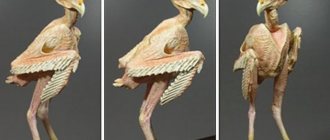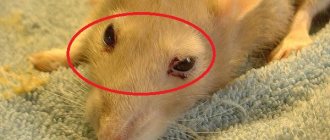Hamsters are quite popular pets, which seem to be completely unpretentious and do not require much of your time or careful care. In some ways this is true, hamsters do not require as much attention as, for example, dogs. But you need to take care of hamsters regularly and very carefully, monitoring what they eat and the conditions in which they live. Otherwise, you may encounter health problems with your pet. In this article we will talk about eye diseases of these animals. Why do hamsters have red eyes? Why do they turn sour or become bulging? How to recognize the first symptoms and how to treat the animal in order to destroy the source of the disease as quickly as possible.
Main Causes of Eye Diseases in Hamsters
Hamsters are quite sensitive to various types of infections, and they are also often affected by senile illnesses. Conventionally, the main causes of eye diseases can be divided into several categories:
- Unsanitary living conditions. Hamsters often need to clean their house and change their bedding because harmful microorganisms easily multiply in it. We all know how hamsters love to bury their heads, so it's not surprising that they can easily get an eye infection.
- Eye injuries. Quite often, an animal can damage its eye with a sharp object, stab or hit itself with something. As a result, the hamster's eye becomes swollen, or begins to water and turn red.
- Allergic reactions. Hamsters can have allergic reactions to certain foods, or even to cleaning products you use to mop the floor or clean the animal's cage.
- As a result of other diseases. If your hamster has had a certain viral disease, this may result in conjunctivitis or other bacterial infections. This is caused by decreased immunity.
- Age-related diseases. When an animal reaches natural old age, eye problems may appear. In particular, these are white spots that cover a significant part of the eye.
Not only old hamsters, but also very young hamsters can get eye problems. In order to prevent a possible disease in time, you need to consult a veterinarian at the first symptoms, who will prescribe the most effective treatment, because not every problem can be treated with the same methods of treatment.
How to treat inflammatory eye diseases
In case of inflammatory diseases, they try to provide rest to the animal. Rinsing is carried out to prevent eyelid sticking, infection and increased discomfort. If the eye is already infected with pathogens, the procedure prevents bacteria from further penetrating into the deeper tissues.
The filler must be removed from the cage. It is replaced with paper towels. All accessories are disinfected with hot water and soap. The cage is placed in a dark place.
Choice of medications
The choice of medications depends on the nature of the pathology. Anti-inflammatory drugs are most often used. The most neutral drug is saline solution. It is used to wash and moisturize the eyes. It does not cause tissue drying, and therefore does not contribute to further infection.
In most cases, antibiotics are included in the treatment regimen, even if there are no signs of bacterial infection. This prevents infection due to weakened immunity.
Preference is given to local drugs, since generic ones are ineffective.
If necessary, the discharge is removed with a soft sterile swab soaked in saline solution. For infection, use Furacilin. If there is no improvement within 2-3 days, use Tobrex or Floxal drops. If necessary, take a long break between washes and add ointment.
Drops for the treatment of inflammatory eye diseases in hamsters.
Cleaning your eyes at home
The eyes are washed with saline solution, weak tea leaves, chamomile infusion or Furacilin. To do this, take a soft swab or cotton swab, moisten it in the product and carefully move it from the corner of the eye towards the outside. You can't go against the grain when eliminating discharge. This will cause dirt to get into deep tissues. Do not press on the skin. This traumatizes the pet. A separate swab is used for each eye.
Diet restrictions
The menu during illness is strictly limited. The pet is fed mainly grain crops, and animal proteins are given in small portions. Diet diversity is avoided due to weakened immunity and the need to reduce the load on the gastrointestinal tract.
Conjunctivitis in hamsters: symptoms and treatment methods
Conjunctivitis is a familiar problem to everyone, but it affects not only people, but also pets. It needs to be treated at the first symptoms, because in a neglected state many more serious sores can be added, some of which can only be solved by surgical intervention.
The first symptom of conjunctivitis is considered to be wet eyes, then more serious troubles are added, such as:
- The hamster's eyes fester, the pus is characteristically green or yellow, especially in large quantities in the morning;
- The eyelids swell;
- The animal cannot fully open its eyes;
- The hamster becomes lethargic and refuses to eat.
Usually, for conjunctivitis, the veterinarian prescribes washing and instillation of the eyes with special drops. Also, a sick animal needs to be subject to some kind of quarantine. Isolate him from other animals that live in your home.
Additional tips regarding treating conjunctivitis in hamsters:
- Careful hygiene. Change the bedding daily, and wash your hands before putting drops in the animal’s eyes;
- Both eyes need to be treated, even if only one is sick;
- Monitor your pet's diet, excluding sweets;
Usually, conjunctivitis can be completely cured in two to three weeks. To avoid re-infection, try to keep the animal's cage clean and play with it after washing your hands.
It is important to know that untimely treatment of this infection can lead to your hamster's eye popping out. It will become unnaturally convex. This can only be corrected through surgery.
Coronavirus in children from 1 year to 5 years
Children aged 1 to 5 years can react to coronavirus infection with a sharp rise in body temperature. Changes in the child's behavior are possible, such as increased moodiness or tearfulness, lethargy and sudden changes in mood.
You can suspect the development of coronavirus in a child based on the following symptoms:
- severe weakness;
- slight cough;
- loss of appetite;
- a sore throat;
- nasal congestion;
- increased body temperature;
- changes in the rhythm and frequency of breathing;
- chest pain;
- dyspnea;
- conjunctivitis;
- gastrointestinal disorder.
The main danger in the form of complications of Covid in children is multisystem inflammatory syndrome (MSI). This is an excessive immune response of the body to the penetration of the virus.
As a rule, DMV develops 1-6 weeks after the acute phase of the disease, even if children have had a mild or asymptomatic form of COVID-19. By this time, in the majority of children who have recovered from coronavirus, PCR tests for covid give a negative result, but antibodies to coronavirus are detected.
As a rule, the first sign of multisystem inflammatory syndrome after Covid in children is a sharp increase in body temperature to high levels (above 38 degrees). Hyperthermia can last for a day or more. A rash may be observed on the body (all over or in certain areas) - macular and/or papular. Characteristic signs of multisystem inflammatory syndrome may include conjunctivitis, scleritis, swollen lymph nodes, and swelling of the palms and feet. One of the common symptoms of DMV is a red or crimson tongue and swollen, bright scarlet lips. The syndrome can lead to damage to the gastrointestinal tract, causing abdominal pain, vomiting, nausea, and diarrhea.
The result of DMVS can be cardiac, renal, hematological, dermatological disorders, as well as damage to the central nervous system, respiratory failure associated with lung damage.
Inflammatory syndrome after covid is more often observed in children from 2 to 5 years old, but older children are susceptible to it.
Most often, coronavirus in children under 6 years of age is asymptomatic . But the asymptomatic course of the disease is not a reason to relax and not monitor the child’s condition. The virus, penetrating the body, causes an immune response and can affect other systems. Therefore, children should be under outpatient supervision of a pediatrician for several months from the onset of infection with a new coronavirus infection.
Eye diseases associated with aging changes in the body
Very often, with age, hamsters develop such an unpleasant disease as cataracts. It manifests itself as white spots, clouding of the lens, and blurred vision. The animal gets really stressed because it begins to see poorly. Unfortunately, this disease can rarely be cured; all that remains is to make the animal’s life as easy as possible by following certain tips:
- Do not place the hamster's cage in direct sunlight, this will further irritate the eyes and worsen the situation;
- Don't give your animal a lot of sweets. In return, give a lot of carrots and zucchini.
- Do not place many objects in the cage, because due to poor eyesight the animal may hit them and injure itself.
This is all you can do for your pet to somehow make his life easier.
Blepharitis
Blepharitis is a complication of advanced conjunctivitis. With this pathology, the inflammatory process completely engulfs the eyelids, causing them to become poisonous red. The fur begins to come out all over the face. The animal suffers from severe itching, the hamster constantly rubs its sore eyes. Also, the eyelids swell greatly, sometimes acquiring a bluish tint.
The treatment of this disease is similar to the treatment of conjunctivitis. However, drops alone are not enough. In addition to them, tetracycline ointment should be used. It is used to treat the eyelids from the outside 2-3 times a day.
Of course, before dripping medicine into the eyes, they must be washed and the accumulated pus removed. This can be done with chamomile infusion or tea.
Other diseases in hamsters that may cause eye problems
Eye infections are not always the reason why a hamster’s eyes are watery or other problems with the organs of vision have appeared. Sometimes the problems are completely different, and eye discomfort is just a side effect.
For example, inflammatory processes in the cheek pouches. In this case, the cheek may become swollen and, as a result, the hamster's eye closes. In this case, there is no need to put drops in your eyes or smear them with ointment, it will not be effective. The cheeks should be cleaned; this should only be done by a veterinarian.
Another common problem is an abscess in the hamster as a result of a strong blow, bites from other rodents and the like. For example, a bump or swelling in the head area, if the blow lands there, can cause redness of the eyes.
It’s great if you notice swelling in the initial stages, in which case you can get by with taking antibiotics, but if this moment was missed, a purulent wound may develop. This problem requires more serious treatment, often surgical intervention.
Under no circumstances should you self-prescribe medications to an animal. Sometimes rodents may not tolerate certain medications, this will lead to fatal consequences.
Only after a complete examination of the animal can the veterinarian correctly prescribe treatment. Sometimes, it may be necessary to open and wash the wound, install drainage, and apply sutures. Sometimes the abscess opens on its own, then the doctor performs a slightly different series of manipulations, which also include washing and disinfecting the diseased area of the body.
In what cases should you contact a veterinarian?
Sometimes trying to help a pet on your own is the worst idea, since unnecessary delay can lead to very sad consequences. Here are the cases in which you need to contact a veterinarian immediately:
- The animal feels so bad that it eats poorly or refuses food altogether. If your pet refuses water, you should call a doctor immediately, regardless of the time of day.
- Severe weakness and apathy. For normally active hamsters, these signs are atypical and strongly indicate serious health problems.











